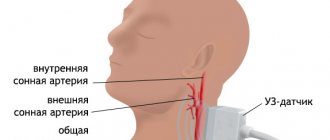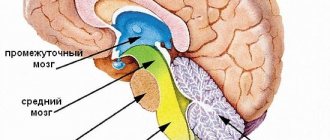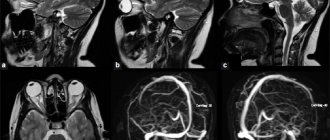Craniography is a diagnostic method based on radiography of the skull without the use of contrast agents. The technique is very simple and does not require much experience or a high level of education of the specialists performing it.
Craniography is performed using a simple X-ray machine, usually in frontal and lateral projections. If the patient’s health condition does not allow him to turn the patient’s head to the sides, one survey projection will be sufficient for diagnosis. There is no need to use contrast agents; the condition of the skull will be clearly visible without them, and this is the main value of this research method.
Types of brain diseases
Any disease that affects the walls of blood vessels in the brain leads to disruption of the functioning of not only other organs, but also the entire body. Most men who have reached the age of forty experience so-called cluster pain. They manifest themselves in the form of attacks of very sharp pain, developing into a chronic disease. The causes of this problem may be hormonal imbalance, vascular aneurysm, or the presence of a pituitary tumor. If you have such pain, you should see a doctor in a timely manner for a thorough examination. Let's look at the most common diseases:
1. Alzheimer's disease
Atrophy of nerve cells occurs due to the production of pathological and harmful protein to the body. The initial stage of the disease has virtually no symptoms, but the Alzheimer's patient becomes more inattentive and distracted.
2. Malignant and benign brain tumors
The formation of proliferating cells, the nature of which is not characteristic of the human brain. New growths increase in size, and thereby the pressure inside the skull increases. The main symptom characterizing the presence of a tumor is a headache that occurs in the morning and is accompanied by vomiting. Over time, there is a noticeable deterioration in memory and thought process, and serious mental disorders occur.
3. Epileptic seizures
Disorder of brain functions of a recurrent nature. During the onset of epilepsy, the patient may lose consciousness and experience limb spasms. In a generalized seizure, both hemispheres are affected; in a local seizure, one of the two is affected.
4. Benign headaches
They are not related to serious damage to areas of the brain. Usually caused by weather conditions and uncomfortable hats. However, if you experience frequent and systematic pain, you should consult a doctor to schedule an examination to rule out the presence of serious pathological changes in the body, tissues and blood vessels of the brain.
5. Vegetative-vascular dystonia
A disease most common among young people. It is characterized by a disorder of the nervous system and is accompanied by severe headaches, attacks of irritability and psychosis, and decreased ability to work. Sometimes a headache is accompanied by vomiting, severe heart pain, and high blood pressure.
6. Vascular diseases
One of the most dangerous groups of brain diseases that cause serious harm to the human body, in most cases causing severe consequences and dangerous damage to tissues and organs. A vascular disease never goes away without leaving a trace, so the patient can suffer severe complications in the form of partial or complete paralysis, as well as remain disabled for life.
Let's take a closer look at the main causes of vascular diseases:
What causes vascular diseases of the brain?
1. Vascular atherosclerosis;
2. Hypertension;
The intracerebral vascular system, carotid artery and other areas are damaged, after which the first signs and symptoms of the disease appear.
Forms of the disease
- transient disorders affecting the circulatory system in the brain;
- failure to supply power to the brain, which leads to necrosis and resorption of the organ;
- arterial blockage;
- damage to the walls of blood vessels;
- bleeding in the brain (stroke).
Stroke is a disruption in the circulatory system that is accompanied by tissue damage and functional disorders of the body. The main symptoms signaling the risk of a stroke: increasing tinnitus, a feeling of heaviness in the skull, loss of strength, dizziness. The severity of the disease depends on the degree of arterial disorders and the volume of the affected area of the brain. Since a stroke takes the patient by surprise, it is not always possible to call doctors for help in time, who could influence the further consequences of such a serious and dangerous disease, often leading to death.
Another name for transient disorders is discirculatory encephalopathy, accompanied by vascular spasms in the form of a headache of a strong or weak nature. These are changes and disorders characterized by vascular insufficiency of brain cells. The disease occurs against the background of atherosclerosis, hypertension problems or diabetes mellitus of any stage. It is important to diagnose the disease at an early stage to stop or minimize the progression of encephalopathy. Symptoms of the disease: headaches, emotional instability. Over time, serious problems with intellectual abilities, speech, memory loss, fainting and partial blindness, numbness, impaired tactile functions, and a feeling of weakness throughout the body are observed.
3. Atherosclerosis.
At the initial stage, the disease does not always make itself felt, so it is possible to detect the presence of the disease only with the help of special medical means of modern diagnostics. Timely diagnosis and correctly prescribed treatment make it possible to save as many patients as possible and reduce the risk of dangerous prognosis of the disease to a minimum.
What symptoms indicate an unfavorable course?
What signs of brain cancer indicate an unfavorable course of the tumor? These are signs of damage to the brain stem. It is very small, but the trunk contains vital centers that regulate breathing and blood circulation. If a malignant tumor grows into the trunk, then the clinical picture can progress very quickly, and 3-4 months, or even less, may pass from the first manifestations of the disease to death.
Symptoms of trunk damage are bulbar syndrome. There is a swallowing disorder, choking, hoarseness and nasal voice. At first it is difficult to swallow solid food, then liquid food, and then swallowing becomes impossible. Respiratory and cardiac disorders are associated. Death may occur from cardiac arrest, and since the tumor is small, there may be no dizziness, nausea, or other signs.
In conclusion, I need to give some advice. Now it's the 21st century. It is better not to guess how the first signs of brain cancer appear, but to go and perform magnetic resonance imaging, and then come to an appointment with a neurologist. All this can be done in a few hours, and after that all your suspicions will most likely dissipate.
Diagnostic methods for studying the brain
Currently, in medical practice, only the most advanced and accurate methods are used to help examine in detail the nature and nature of the disease and establish or confirm a diagnosis, and then prescribe a plan for further therapy.
Most often, the disease is not accompanied by any serious visible abnormalities, so it is extremely important to identify the disease at an early stage of progression. In order to correctly diagnose the disease, the attending physician collects an anamnesis, to which the results of studies and observations of the patient’s condition are added. You can examine the state of the brain and detect disorders caused by the disease using the following methods:
1. Echoencephalography
This procedure is prescribed if the doctor suspects the presence of a tumor or if the patient has suffered a traumatic brain injury. Ultrasound is reflected from the area under study, recorded by an oscilloscope, and then the resulting signal is displayed on the monitor. The results of the study show pathological changes, the degree of deviation and displacement of brain structures.
2. Doppler ultrasound
Using this completely painless method, a study is carried out that can assess the condition of blood vessels and blood circulation in the head and neck. Doppler ultrasound is also used to monitor the progress of prescribed treatment or identify signs of vascular pathologies.
3. Rheoencephalography
REG records changes in electrical tissue resistance in the form of pulse oscillations. This method diagnoses the presence of tumors, traumatic disorders, epileptic signs, and migraines. REG also determines the blood content of the brain and local affected areas.
4. Magnetic resonance imaging and angiography
One of the most accurate and highly informative and widespread scanning methods, the action of which is based on nuclear magnetic resonance. Echo signals displayed from the organ under study and formed under the pulsed influence of radio frequencies form a complete picture of the state of the brain on a computer monitor. You can sign up for an MRI of the brain on our portal.
Angiography of the brain is only being improved in modern medicine, being quite promising and making it possible to construct a three-dimensional image of the vascular system of the studied area of the brain and establish hemorrhage, examine the surface of the brain and monitor the physical and chemical processes of the organ.
5. Electroencephalography
Registration of electrical oscillations of brain potentials. Electrodes are attached to the patient's head, reading biocurrents. The obtained data is recorded on paper. As a rule, such a procedure is prescribed if the patient has disturbances in psycho-speech development, epileptic seizures and injuries.
6. Electroneuromyography
It is used if it is necessary to determine the presence of peripheral nerve damage or neuromuscular problems through bioaccurate muscle recording.
7. Neurosonography
The method is able to detect pathological changes in the early stages. Its action is based on ultrasound, which is used to study the structure of the brain not only of an adult, but also of a newborn.
8. Craniography
Cranial radiography performed in two projection forms. The method detects congenital brain defects, as well as skull fractures.
9. Computed tomography
X-rays pass through the brain tissue, and their intensity and speed of movement are recorded. Thanks to this diagnostic procedure, the doctor will be able to examine areas of the brain at different plane levels. The computed tomography method reveals not only acquired, but also congenital defects, the nature of existing pathologies and the source of their spread.
10. Positron emission tomography
The use of radiopharmaceuticals to create a three-dimensional image of functional brain processes. PET determines the nature of the tumor and diagnoses the consequences of injuries.
When diagnosing brain diseases, complex clinical cases are also encountered, since the patient may have Moyamoya or Binswanger disease. Both of these diseases can provoke thrombotic strokes.
Indications for craniography
Indications for diagnosing and clarifying the diagnosis may be the following diseases and conditions of the patient:
- Intracranial hemorrhage.
- Extensive cerebral stroke.
- Cerebral infarction.
- Pathological changes in the size and shape of the bones of the skull.
- Determination of localization sites of cranial hernias, extracranial neoplasms, platybasia.
- Identification of the causes of inflammatory processes.
- Porosity of parts of the sella turcica.
- Reasons for limiting intracranial space.
Therapeutic stage of disease treatment
Let's consider the features of treatment of the most dangerous group of brain diseases.
First, the treatment plan is designed to eliminate the symptoms of hypertension and atherosclerosis. Special medical substances prescribed by a doctor normalize fat metabolism and also maintain normal blood pressure. All these stages are extremely important for restoring normal brain activity.
In atherosclerosis, atherosclerotic plaques that interfere with blood vessels and affect the circulatory system are removed. In many cases, the affected vascular part is replaced.
It is impossible not to note the rehabilitation recovery process, which includes not only physiotherapeutic procedures and radiation therapy, but also therapeutic exercises performed under the guidance of a doctor.
Plot
A young guy, Michael (Edward Furlong), on the advice of a friend, purchases the computer game “Brain Scanning”. The game penetrates his subconscious through a television signal, forcing him to find himself in a virtual reality that is no different from the real world. According to the plot of the game, Michael has to kill a man and cut off his foot so that an invisible commentator named Trickster (English Trickster, played by Ryder Smith) will count the completion of the task. The next day, Michael learns from the news about a brutal murder that took place in the next block, and looking into his refrigerator, he discovers the victim’s foot. The guy realizes with horror that the murder actually happened, and moreover, he committed it. At the same time, the Trickster mysteriously emerges from the TV and forces Michael to continue the game, threatening to turn him over to the police in the person of Detective Hayden (Frank Langella) if he refuses.









